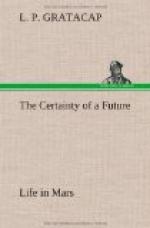The rooms of our physical laboratory at Irvington were almost all lit by electric lamps constructed somewhat on the principle of Edison’s, but using platinum wires, and the old residents of that village may recall the singular, lonely house half hidden in broad sycamores, sending out its electric radiance late at night while my father and frequently myself, then a boy of thirteen years, worked at experimental problems in physics.
My father gave my precocity for science a very successful impetus and left me at his death fully in possession of the ideas and projects he cherished. Amongst these projects, one partially realized, was the acceleration of plant growth by means of electric light, and heating by electricity.
Dr. Siemens of England, it may be recalled, had very ingeniously experimented upon the influence of the electric light upon vegetation. In a paper read by that distinguished man before the Society of Telegraph Engineers in June, 1880, he referred to his conclusion that “electric light produces the coloring matter, chlorophyll, in the leaves of plants, that it aids their growth, counteracts the effects of night frosts, and promotes the setting and ripening of fruit in the open air.”
I find in an old note book of my father’s, dated 1879, “chlorophyllous matter in leaves encouraged by electric energy, presumably by the blue rays.” In heating and cooking by electricity my father had made some progress though he had not in 1880 employed his time in this direction.
Perhaps more remarkable than anything else presenting my father’s great scientific ingenuity was his improvements of the dynamo and the invention of a new successful small traction engine.
In 1880 the complete distinction between alternating and direct currents had not been made, and the device of a successful converter, for the change of the former comparatively inert to the latter’s dynamic condition, only dreamed of. Yet in my father’s notebook I find this suggestive sentence: “It seems possible to devise an apparatus which would deliver from an alternating circuit a direct current to a direct current circuit.”
I have dwelt somewhat upon my father’s scientific acquirements and genius in order to impress upon the reader the strictly legitimate training I received in scientific procedure, and I have instanced somewhat the status of his scientific development in 1880, because it was at that time that he concluded to leave Irvington and locate his laboratory and observatory elsewhere. And for the sake of his astronomical interests he determined to find some place peculiarly well fitted, on account of its atmospheric advantages, for astronomical observations. It is necessary likewise to recall some of the facts then known to astronomers and my father’s own theories, in order to weave into a logical sequence the incidents leading up to my positive demonstration of a future life for some of our race in the planet Mars.




